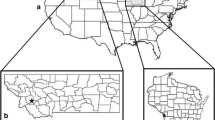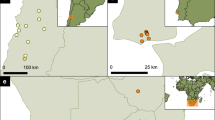Abstract
Elucidating the mechanisms making a successful invader remains a central problem in invasion ecology. There is growing evidence supporting that the outcome of competition between species can be controlled by parasites. However our understanding of how parasites affect the interaction between native and invasive species is very limited. Here we explore the role of parasites as potential agents mediating the competitive exclusion of populations of Mediterranean brine shrimps Artemia by the exotic American A. franciscana, which is leading in most of the cases to the extinction of native Artemia populations. We compared the susceptibility of the invasive species and the native A. parthenogenetica to different cestode species using an exceptional case of sympatry in Aigues-Mortes saltern, South of France. The invader A. franciscana showed greatly reduced diversity, low prevalence and low burden of cestode larvae compared to its native congener. Infection in A. parthenogenetica was associated with high fitness costs. In particular, the most prevalent cestode, Flamingolepis liguloides caused castration in A. parthenogenetica. The results of this study suggest that the large impact of cestode on the native, but not the invading species, is likely to confer a decisive competitive advantage to the invader. It thus certainly contributes to explain the demographic success of A. franciscana in the Mediterranean region.




Similar content being viewed by others
References
Aitchison J, Ho C (1989) The multivariate Poisson-log normal distribution. Biometrika 76:643–653
Amarouayache M, Farid D, Hichem KM (2009) The parasitism of Flamingolepis liguloides (Gervais, 1847) (Cestoda, Hymenolepididae) in Artemia salina (Crustacea, Branchiopoda) in two saline lakes in Algeria. Acta Parasitol 54:330–334
Amat F (1983) Zigogenetical and parthenogenetical Artemia in Cadiz sea side salterns. Mar Ecol Prog Ser 13:291–293
Amat F, Gozalbo A, Navarro JC, Hontoria F, Varó I (1991) Some aspects of Artemia biology affected by cestode parasitism. Hydrobiologia 212:39–44
Amat F, Barata C, Hontoria F, Navarro JC, Varó I (1995) Biogeography of the genus Artemia (Crustacea, Branchiopoda, Anostraca) in Spain. Int J Salt Lake Res 3:175–190
Amat F, Hontoria F, Ruiz O, Green AJ, Sánchez MI, Figuerola J, Hortas F (2005) The American brine shrimp as an exotic invasive species in the western Mediterranean. Biol Inv 7:37–47
Amat F, Hontoria F, Navarro JC, Vieira N, Mura G (2007) Biodiversity loss in the genus Artemia in the Western Mediterranean Region. Limnetica 26(2):387–404
Barata C, Hontoria F, Amat F (1995) Life history, resting egg formation, and hatching may explain the temporal-geographical distribution of Artemia strains in the Mediterranean basin. Hydrobiologia 298(1–3):295–305
Barata C, Hontoria F, Amat F (1996) Estimation of the biomass production of Artemia with regard to its use in aquaculture: temperature and strain effects. Aquaculture 142(3–4):171–189
Britton RH, Johnson AR (1987) An ecological account of a Mediterranean Salina: the Salin de Giraud (Southern France). Biol Conserv 42(3):185–230
Burnham KP, Anderson DR (2002) Model selection and multimodel inference: a practical information-theoretic approach. Springer, New York
Bush AO, Lafferty KD, Lotz JM, Shostak AW (1997) Parasitology meets ecology on its own terms: Margolis et al. revisited. J Parasitol 83:575–583
Clark DT (1954) A new cyclophyllidian cestodefrom the Avocet. J Parasitol 40:340–346
Colautti RI, Ricciardi A, Grigorovich IA, MacIsaac HJ (2004) Is invasion success explained by the enemy release hypothesis? Ecol Lett 7:721–733
Cramps S, Simmons KEL (eds) (1977) The birds of the Western Paleartic, vol 1. Oxford University Press, Oxford
Dunn AM (2009) Parasites and biological invasions. Adv Parasitol 68:161–184
Gabrion C, MacDonald-Crivelli G, Boy V (1982) Dynamique des populations larvaires du cestode Flamingolepis liguloides dans une population d’Artemia en Camargue. Acta Oecol 3:273–293
Georgiev BB, Sánchez MI, Green AJ, Nikolov PN, Vasileva GP, Mavrodieva RS (2005) Cestodes from Artemia parthenogenetica (Crustacea, Branchiopoda) in the Odiel Marshes, Spain: a systematic survey. Acta Parasitol 50(2):105–117
Georgiev BB, Sánchez MI, Vasileva GP, Nikolov PN, Green AJ (2007) Cestode parasitism in invasive and native brine shrimps (Artemia spp.): can it explain the rapid invasion of A. franciscana in the Mediterranean region? Parasitol Res 101:1647–1655
Green AJ, Sánchez MI, Amat F, Figuerola J, Hontoria F, Hortas F (2005) Dispersal of invasive and native brine shrimp Artemia (Anostraca) via waterbirds. Limnol Oceanogr 50:737–742
Gulbrandsen J (2001) Artemia swarming mechanisms and suggested reasons. J Plank Res 23(7):659–669
Hontoria F, Amat F (1992a) Morphological characterization of adult Artemia Crustacea, Branchiopoda) from different geographical origin. Mediterranean populations. J Plank Res 14(7):949–959
Hontoria F, Amat F (1992b) Morphological characterization of adult Artemia (Crustacea, Branchiopoda) from different geographical origin. American populations. J Plank Res 14(10):1461–1471
Keane RM, Crawley MJ (2002) Exotic plant invasions and the enemy release hypothesis. Trends Ecol Evol 17:164–170
Kolar CS, Lodge DM (2001) Progress in invasion biology: predicting invaders. Trends Ecol Evol 16:199–204
Lenz PH, Browne RA (1991) Ecology of Artemia. In: Browne RA, Sorgeloos P, Trotman CNA (eds) Artemia biology, vol 10. CRC, Boca Raton, Florida, pp 237–253
Liu H, Stiling P, Pemberton RW (2007) Does enemy release matter for invasive plants? Evidence from a comparison of insect herbivore damage among invasive, non-invasive and native congeners. Biol Inv 9:773–781
Maksimova AP (1976) A new cestode, Fimbriarioides tadornae sp. n., from Tadorna tadorna and its development in the intermediate host. Parazitologiya 10:17–24 (in Russian)
Martin GR, Jarrett N, Tovey P, White CR (2005) Visual fields in Flamingos: chick-feeding versus filter-feeding. Naturwissenshaften 92:351–354
Mitchell CE, Power AG (2003) Release of invasive plants from fungal and viral pathogens. Nature 421:625–627
Mura G, Amat F, Abatzopoulos TJ, Moscatello S (2004) First record of Artemia franciscana in an Italian saltwork. Book of abstracts 35–36. Fifth international large branchiopod symposium, Aug 2004. Toodyay, Western Australia
Patterson J, Furse C (2009) The shelduck: a study in behavioural ecology. Cambridge University Press, Cambridge
Redón S, Amat F, Hontoria F, Vasileva GP, Nikolov PN, Georgiev BB (2011) Participation of metanauplii and juvenile individuals of Artemia parthenogenetica (Branchiopoda) in the circulation of avian cestodes. Parasitol Res 108(4):905–912
Reeve MR (1963) The filter-feeding of Artemia. II. In suspensions of various particles. J Exp Biol 40:207–214
Robert F, Gabrion C (1991) Cestodoses de l’avifaune Camarguaise. Rôle d’Artemia (Crustacea, Anostraca) et stratégies de recontre hôte-parasite. Annales de Parasitologie Humaine et Comparée 66:226–235
Sánchez MI, Green AJ, Castellanos EM (2006a) Temporal and spatial variation of an aquatic invertebrate community subjected to avian predation at the Odiel salt pans (SW Spain). Arc für Hydrobiol 166:199–223
Sánchez MI, Georgiev BB, Nikolov PN, Vasileva GP, Green AJ (2006b) Red and transparent brine shrimps (Artemia parthenogenetica): comparative study of their cestode infections. Parasitol Res 100(1):111–114
Sánchez MI, Georgiev BB, Green AJ (2007) Avian cestodes affect the behaviour of their intermediate host Artemia parthenogenetica: an experimental study. Behav Proc 74:293–299
Sánchez MI, Thomas F, Perrot-Minnot MJ, Bertrand-Michel J, Biron DG, Missé D (2009a) Neurological and physiological disorders in Artemia harboring manipulative cestodes. J Parasitol 95(1):20–24
Sánchez MI, Hortas F, Figuerola J, Green AJ (2009b) Sandpipers select red brine shrimps rich in carotenoids but also parasites. Ethology 115:196–200
Thiéry A, Robert F, Gabrion C (1990) Distribution des populations d’Artemia et de leur parasite Flamingolepis liguloides (Cestoda, Cyclophyllidea), dans les salins du littoral méditerranéen français. Can J Zool 68:2199–2204
Torchin ME, Lafferty KD, Dobson AP, McKenzie VJ, Kuris AM (2003) Introduced species and their missing parasites. Nature 421:628–630
Vasileva GP, Redón S, Amat F, Nikolov PN, Sánchez MI, Lenormand T, Georgiev BB (2009) Records of cysticercoids of Fimbriarioides tadornae Maksimova, 1976 and Branchiopodataenia gvozdevi (Maksimova, 1988) (Cyclophyllidea, Hymenolepididae) from brine shrimps at the Mediterranean coast of Spain and France, with a key to cestodes from Artemia spp. from the Western Mediterranean. Acta Parasitol 54(2):143–150
Wolfram S (1999) The mathematica book, 4th edn. Wolfram Media/Cambridge University Press, Cambridge
Acknowledgments
We thank A. Marchand and F. Gout for their help in the field, B. Georgiev and P. Nikolov for checking controversial cestode identification. We also thank A. J. Green and anonymous referees for valuable comments on the manuscript. This work has been supported by the ERC grant Quantevol to T. L.
Author information
Authors and Affiliations
Corresponding author
Electronic supplementary material
Below is the link to the electronic supplementary material.
Rights and permissions
About this article
Cite this article
Sánchez, M.I., Rode, N.O., Flaven, E. et al. Differential susceptibility to parasites of invasive and native species of Artemia living in sympatry: consequences for the invasion of A. franciscana in the Mediterranean region. Biol Invasions 14, 1819–1829 (2012). https://doi.org/10.1007/s10530-012-0192-2
Received:
Accepted:
Published:
Issue Date:
DOI: https://doi.org/10.1007/s10530-012-0192-2




